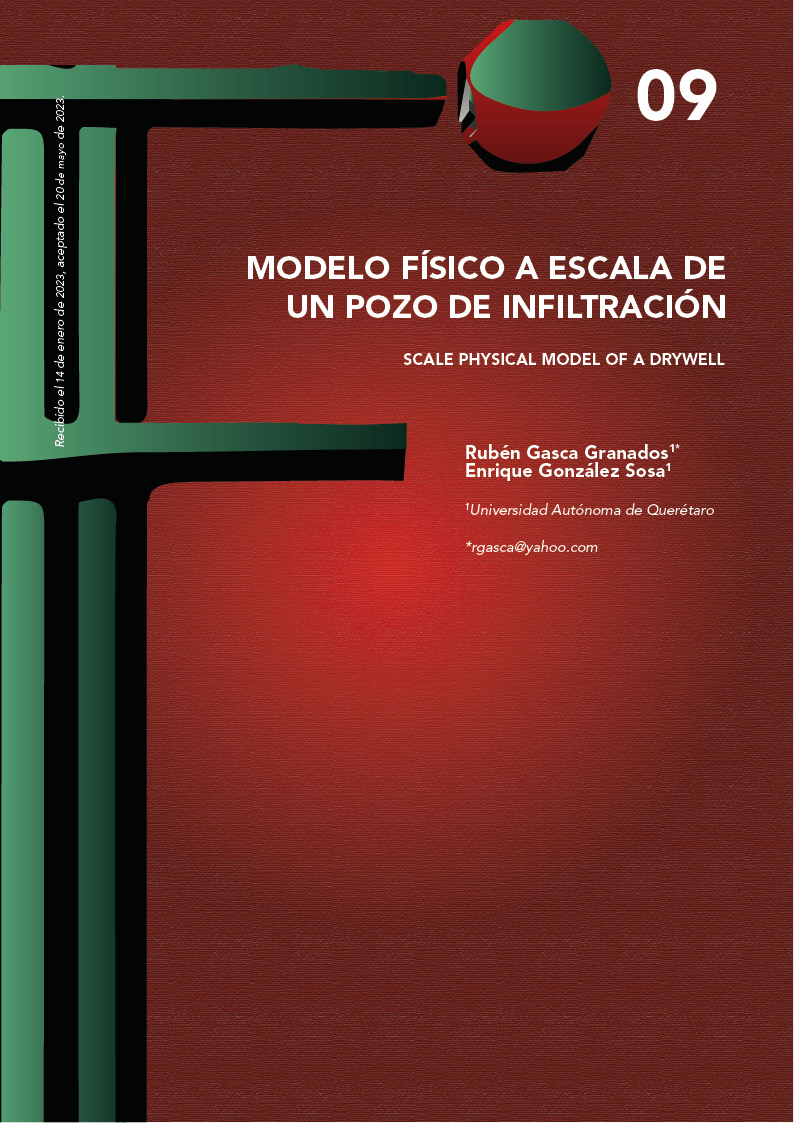Abstract
The accelerated growth in population is causing pressure on the availability of water resources, specially overexploited groundwater. To help nature, aquifer recharge is convenient, given the fact that quality and supply are guaranteed, without environmental deterioration. However, efficiency and functionality of aquifer recharge depends on soil characteristics and properties, as well as other factors. This works presents the methodology of implementing a scale physical model of a drywell with the goal of investigating the process of infiltration, and to improve its functioning under permanent flow conditions. Tests under steady and permanent flow conditions, with and without soil, were performed. Fifteen pressure transducer sensors, centralized to an Arduino Mega motherboard, were adapted to the well. Calibration of transducers was performed hydrostatically. Their behavior was lineal and then, adjusted with linear regression. Three tests under permanent flow (sand, sand-clay, and clay-sand) were performed, observing that the sensors responded according to the expected lineal behavior in the three different tests. In summary, the scale model represents adequately and drywell.
References
Bonnet, J. a. 1960. El Agua en el Suelo. Agronomy Journal, 52, 491. https://doi.org/10.2134/agronj1960.00021962005200080030x
Bouwer Herman. 2002. Artificial recharge of groundwater: hydrogeology and engineering. Hydrogeology Journal (2002) 10:121–142. DOI 10.1007/s10040-001-0182-4. Published online: 26 January 2002.
Briaud, J. L. (2013). Geotechnical engineering: unsaturated and saturated soils. John Wiley & Sons.
Comisión Nacional del Agua. 2019. Estadísticas del Agua en México, edición 2018. Impreso en México, 225 pág. CONAGUA.
Cortez, F., Javier, 2012. Recarga artificial de acuíferos mediante Pozos de absorción. Tesis de licenciatura. Santiago de Chile, 2012
DOF 2015. Actualización de la disponibilidad media anual del agua en el acuífero Valle de Celaya (1115), Estado de Guanajuato, CONAGUA.
Edwards Emily C., Harter Thomas, Fogg Graham E., Washburn Barbara, Hamad Hamad. 2016. Assessing the effectiveness of drywells as tools for stormwater management and aquifer recharge and their groundwater contamination potential. Journal of Hydrology 539 (2016) 539–553. http://dx.doi.org/10.1016/j.jhydrol.2016.05.059
Edwards Emily Clare. 2017. Assessing the Groundwater Contamination Risk of Drywell-Induced Stormwater Infiltration Using Analytical and Numerical Methods.
Jean-Louis Briaun. 2013. Geotechnical Engineering: Unsaturated and Saturated Soils. Edit. John Wiley & Sons. Impreso Nueva Jersey en 2013, EUA. Pag. 983
R. P. Moston, and S. F. Versaw.A. I. Johnson, R. P. Moston, and S. F. Versaw. Laboratory study of aquifer properties and well design for an artificial recharge site. GSWS, paper 165)
Steven. A Huges, 1993. Physical models and laboratory Techniques in Coastal Engineering. Avanced series in Coastal Engineering, Volume 7. World Scientific.
Weeks, E. P. (1979), Barometric fluctuations in wells tapping deep unconfined aquifers, Water Resour. Res., 15( 5), 1167– 1176, doi:10.1029/WR015i005p01167.
R. P. Moston, and S. F. Versaw.A. I. Johnson, R. P. Moston, and S. F. Versaw. Laboratory study of aquifer properties and well design for an artificial recharge site. GSWS, paper 165).
Jódar-Abellán, A., Albaladejo-García, J. A., & Prats-Rico, D. (2017). Artificial groundwater recharge. Review of the current knowledge of the technique. Revista de la Sociedad Geológica de España, 85-96.
Janney, J. R., Breen, J. E., Geymayer, H., Lockman, W. T., & Rocha, M. (1970). The Use of models in structural engineering. Special Publication, 24, 1-18.
Sasidharana Salini, Bradfordb Scott A., Šimůneka Jiří, Kraemerc Stephen R. 2020. Groundwater recharge from drywells under constant head conditions. Journal of Hydrology 583 (2020) 124569. https://doi.org/10.1016/j.jhydrol.2020.124569

This work is licensed under a Creative Commons Attribution-NonCommercial-ShareAlike 4.0 International License.
Copyright (c) 2023 Perspectivas de la Ciencia y la Tecnología

